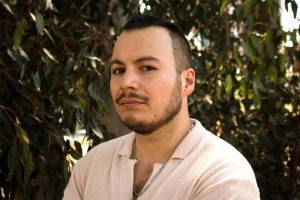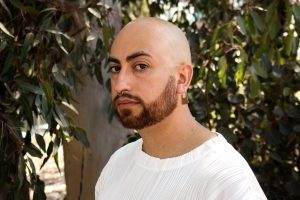Whispering to my soul: when ancestors call us to resurgence
By Antonio Catrileo
Whispering to my soul (2021) by Esperanza Sánchez Espitia is a sensitive invitation that explores the connection to our ancestors through dreams. Dreaming here is a way of reclaiming non-Western ancestral knowledge that breaks down the linearity of time. The dream dimension is a space where knowledge is shared beyond Western notions of time and rationality. The film goes beyond the aestheticization of the oneiric world as surreal. As a bridge, or maybe as a generous conversation with the ancestors, the film is an invitation to think about ways to resist oblivion. In Sánchez’s film there is an invocation of how her ancestors, who become guides through the camera, are trying to recompose fragments of a story. It is a call to resurgence, where the camera travels through different materialities which act as signs to follow. A path of memory, lived experiences, and also intuition are part of a long threat, shredded by linear time, as a metaphor for colonialism.
Whispering to my soul uses the act of whispering as a breath, as remembrance, demonstrating how a scream is a vital act to call the ancestors to speak. The film begins with echoes and sounds in reverse that create an immersive experience and alter the straight line of progressive time, where past-present-future moves just in one direction. But in this piece, the sonority of whispering reclaims the circularity of time, where the film became a journey that seeks to disrupt “Western noise,” as the voice in the film said. What does it mean to whisper? What differentiates a whisper from a song or a noise? Is it possible that in this gesture of whispering a scream also emerges?
The voice in the film appears as a thread, where time is composed in a circular way, linking each image. “It is time to break your own silence, be brave!” the voice declares, spoken as if it were the ancestors themselves who made this call. This expression, its sonic resonance, is reminiscent of rushing rivers who have their own rhythm, their own sonority. Akin to birds that sing and travel from one place to another transmitting their song, Whispering to my soul traces its own journey by weaving small fragments of personal archives.
It is a film that emerges from death, pointing out the movement implied by death as a transforming force, as a bridge to life. Whispering to my soul evokes a search as well as a spiritual sense of life, for which Sánchez explores the poetic languages between different elements (water, wind, moon, sun) as a way to create connections with her ancestors. The film is a search for a question about indigeneity, where ancestry is honored in a non-essentialist but experimental way. It is also a way of remembering those who are no longer here, of telling stories to heal the intergenerational trauma of colonial violence expressed in multiple forms up to the present.
The voice is direct in pointing this out. “Oppressive colonialism is not more powerful than your ancestral wisdom,” it says. “You are not alone […] You are not an orphan.” The whisper is calling for the resurgence of communality, where the way in which the human is situated is in direct relationship with all biodiversity, including the celestial bodies. The words whispered remind us that we are a part of a constellated relationship that makes possible a conversation with the world of the invisible and intangible. The whisper is a bridge to the ancestors where the film is a means by which these voices coexist. In this sense, the attempt to alter linear time also offers a reflection on how modernity-coloniality is a transhistorical process that has erased and eradicated the indigeneity of many people in Latin America.
Esperanza Sánchez Espitia was born in Colombia, where she grew up and lived for many years. However, she moved to Canada as a result of various forms of violence that forced her to seek refuge away from her home. It is in this context that her artistic practice emerges. Through film, she transits between worlds and geographies. Whispering to my soul explores the impossibility of returning to the place of origin, of brokenness and forced migration, but it is also a recomposition of that memory materialized in the film; it is a flourishing against silence.
 Antonio Catrileo (they/them) is a Mapuche writer, artist, and weaver from Pikunmapu/Qullasuyu (Curico, Chile). Currently is a student at the PhD in Ethnic Studies at the University of California San Diego. They hold a B.A., M.A. in Chilean and Hispanic Literature at Pontificia Universidad Católica de Valparaíso. Author of the book “Awkan epupillan mew:dos espíritus en divergencia” (2019) and “Diáspora”(2015). Member of the Catrileo+Carrión Community, where they have collectively published the books “Poyewün Nütramkan Pikunmapu/Qullasuyu” (2020), “Poyewün witral: bitácora de las tejedoras de Neltume” (2019), “Torcer la palabra: escrituras obrera-feministas” (2018) and “Yikalay pu zomo Lafkenmapu” (2018). Currently is a collaborator of Global Center for Advanced Studies Latin America Collective. Their work is presented as a critical intervention in how colonial categories have been imposed on notions of sexuality and gender in the Mapuche context. Catrileo claims the word epupillan (two-spirit) as a generative practice that focuses on not reproducing the damage of the archive’s narratives in order to imagine a Mapuche futurity beyond the politics of recognition, nation, and identity. Epupillan is a situated knowledge shared by several elders who are HIV/AIDS activists and defenders of the land.
Antonio Catrileo (they/them) is a Mapuche writer, artist, and weaver from Pikunmapu/Qullasuyu (Curico, Chile). Currently is a student at the PhD in Ethnic Studies at the University of California San Diego. They hold a B.A., M.A. in Chilean and Hispanic Literature at Pontificia Universidad Católica de Valparaíso. Author of the book “Awkan epupillan mew:dos espíritus en divergencia” (2019) and “Diáspora”(2015). Member of the Catrileo+Carrión Community, where they have collectively published the books “Poyewün Nütramkan Pikunmapu/Qullasuyu” (2020), “Poyewün witral: bitácora de las tejedoras de Neltume” (2019), “Torcer la palabra: escrituras obrera-feministas” (2018) and “Yikalay pu zomo Lafkenmapu” (2018). Currently is a collaborator of Global Center for Advanced Studies Latin America Collective. Their work is presented as a critical intervention in how colonial categories have been imposed on notions of sexuality and gender in the Mapuche context. Catrileo claims the word epupillan (two-spirit) as a generative practice that focuses on not reproducing the damage of the archive’s narratives in order to imagine a Mapuche futurity beyond the politics of recognition, nation, and identity. Epupillan is a situated knowledge shared by several elders who are HIV/AIDS activists and defenders of the land.
 Manuel Carrión Lira (he/they) is a Pikunche researcher, video-artist, and curator from Pikunmapu/Qullasuyu (Quillota, Chile). They are a PhD Candidate in Cultural Studies in Department of Literature at the University of California San Diego. Manuel holds a M.A. in Latin American Art, Thought and Culture from the Instituto de Estudios Avanzados at Universidad de Santiago de Chile, and a B.A. in Design at Universidad de Valparaíso. Member of the Catrileo+Carrión Community, where they have collectively published the books “Poyewün Nütramkan Pikunmapu/Qullasuyu” (2020), “Poyewün witral: bitácora de las tejedoras de Neltume” (2019), “Torcer la palabra: escrituras obrera-feministas” (2018) and “Yikalay pu zomo Lafkenmapu” (2018). Manuel is part of the Global Center for Advanced Studies Latin America Collective. Manuel’s work focuses on Indigenous Media at the intersection with Trans-indigenous/Transnational kinship networks beyond the nation-state framework, all of this with special attention to queer/trans/2S/epupillan Indigenous cultural production.
Manuel Carrión Lira (he/they) is a Pikunche researcher, video-artist, and curator from Pikunmapu/Qullasuyu (Quillota, Chile). They are a PhD Candidate in Cultural Studies in Department of Literature at the University of California San Diego. Manuel holds a M.A. in Latin American Art, Thought and Culture from the Instituto de Estudios Avanzados at Universidad de Santiago de Chile, and a B.A. in Design at Universidad de Valparaíso. Member of the Catrileo+Carrión Community, where they have collectively published the books “Poyewün Nütramkan Pikunmapu/Qullasuyu” (2020), “Poyewün witral: bitácora de las tejedoras de Neltume” (2019), “Torcer la palabra: escrituras obrera-feministas” (2018) and “Yikalay pu zomo Lafkenmapu” (2018). Manuel is part of the Global Center for Advanced Studies Latin America Collective. Manuel’s work focuses on Indigenous Media at the intersection with Trans-indigenous/Transnational kinship networks beyond the nation-state framework, all of this with special attention to queer/trans/2S/epupillan Indigenous cultural production.
Communidad Catrileo+Carrion are queer/trans/nonbinary Indigenous epupillan (two-spirit) beings who work articulating generative spaces of reciprocity and relationality. They honor the land and their ancestors through ceremonies materialized in their audiovisual, textile, editorial, curatorial, and community practices. Communidad Catrileo+Carrion reside divided between Pikunmapu/Qullasuyu (Valparaíso Region, Chile) and Kumeyaay Territory (San Diego, California, USA). The group is currently composed of Antonio Catrileo Araya, Constanza Catrileo Araya, Malku Catrileo Araya, Alejandra Carrión Lira, and Manuel Carrión Lira.




